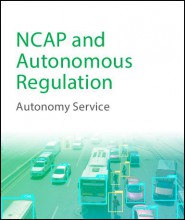
NCAP and autonomous regulations
This report outlines and discusses the various vehicle safety regulations and guidelines influencing the automotive markets globally.
To address the pervasive issue of road crashes and the risk of death or serious injuries to both driver and passengers, regulatory authorities, independent safety bodies, and governmental organizations have been drafting regulations and guidelines. These guidelines are aimed towards improving the crashworthiness and crash avoidance capabilities of vehicles and reduce the fatalities from road crashes.
According to the UN World Health Organization (WHO), more than 1.3 million people lose their lives and another 50 million people get seriously injured due to road accidents. Road crashes are one of the leading causes of death and injury around the world. It’s also the leading cause of death for children and young population between 15 and 30 years, globally. Around 90 percent of these casualties occur in developing countries where vehicle safety regulations are not as strict and updated as compared to countries in the European Union. This has led to the requirement of further improvements in vehicle safety norms to reduce fatalities and serious injuries resulting from road accidents.
Globally, NCAPs are playing a major role in democratizing vehicle safety by empowering consumers, through information, in choosing the safest vehicles they can afford. As of 2018, there are ten regional NCAPs or similar organizations, around the world, working towards testing and evaluation of vehicles for determining their crashworthiness and crash avoidance abilities.
With the advent of self-driving technologies, many countries have been working to lay the groundwork permitting testing of autonomous vehicles on their roads. Additionally, almost, every car assessment programs have started giving significant weightage to active safety technologies while evaluating the overall score for a 5-star rating. Some of the ADAS technologies have already been mandated for new vehicles in various countries around the world such as ABS and ESC, while significant efforts are being given to mandating more advanced driver assistance technologies such as AEB and LDW for improving vehicle safety.
- Introduction
- Overview
- Definitions
- Why regulations and NCAP guidelines for vehicles?
- NCAP review
- Global NCAP
- Euro NCAP
- Australasian NCAP
- ASEAN NCAP
- China NCAP
- Japan NCAP
- Korea NCAP
- Latin NCAP
- BNVSAP
- NHTSA US NCAP
- IIHS HLDI Safer Car Program
- Autonomous vehicle regulations
- ADAS features influenced by regulations
- Active safety regulations
- Conclusion
From key trends affecting today’s business environment to forward-looking forecasts of future output, AutoTechInsight provides the information you need to develop strategy for each of its services.
Staying abreast of automotive sector/topic-specific developments, trends, and competitive activity can be time-consuming. With many sources available, it is often difficult to find critical and reliable market information that stakeholders of the automotive industry need. Conducting business analysis, product, or market strategy assessments without validated market data is risky.
AutoTechInsight provides the ability to access the wealth of recognized thought leadership, data, and analysis from IHS Automotive on a broad spectrum of industry topics and sectors. AutoTechInsight offers a lens into more than a dozen vehicle component categories. Each service provides the insight you need to anticipate future demand, access competitive intelligence, and stay abreast of changing dynamics.
Services coverage include:
|
|





